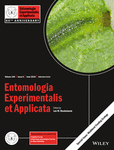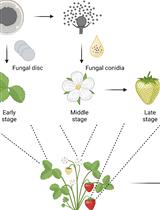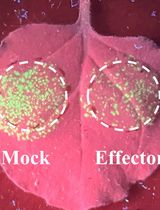- EN - English
- CN - 中文
Quantification of Thrips Damage Using Ilastik and ImageJ Fiji
用Ilastik及ImageJ Fiji定量蓟马危害
发布: 2018年04月20日第8卷第8期 DOI: 10.21769/BioProtoc.2806 浏览次数: 10475
评审: Pengpeng LiEugenio LlorensOliver Xiaoou Dong
Abstract
Quantification of insect damage is an essential measurement for identifying resistance in plants. In screening for host plant resistance against thrips, the total damaged leaf area is used as a criterion to determine resistance levels. Here we present an objective novel method for analyzing thrips damage on leaf disc using the freely available software programs Ilastik and ImageJ. The protocol was developed in order to screen over 40 Capsicum lines for resistance against Frankliniella occidentalis (Western Flower Thrips) and Thrips tabaci (Onion thrips).
Keywords: Insect resistance (昆虫耐药性)Background
Quantification of insect damage is an essential measurement for identifying resistance in plants. In screening programs for host-plant resistance against thrips, the total damaged leaf area is used as a criterion to determine resistance levels. Thrips damage is characterized by silvery spots that show high contrast with the intact leaf area, but the feeding spots also include darker areas ranging from dark green to brown. These gradual discolorations of the leaf are too subtle to precisely quantify with programs such as Winfolia (http://www.regentinstruments.com/assets/winfolia_software.html) or ImageJ (Rasband, 2011) alone. As a result, thrips damage is commonly scored by individuals that rate the samples. Samples are classified into categories signifying the amount of damage (Mirnezhad et al., 2010; Maharijaya et al., 2011 and 2012), or damage is estimated to the nearest 1 mm2 (Leiss et al., 2009; Mirnezhad et al., 2010; Maharijaya et al., 2011 and 2012). These subjective measurements make comparison between studies/screening programs difficult. Moreover, they are time consuming and thus costly for breeding companies. Here we present an objective high-throughput standardized screening method to measure leaf surface damage caused by thrips using the freely available software programs ImageJ Fiji (Schindelin et al., 2012) and Ilastik (Sommer et al., 2011). Ilastik has a wide range of applications ranging from cell biology (Fabrowski et al., 2013), where it is used to compute the amount of surface flattening of epithelial cells, to biomechanics (Bongiorno et al., 2014), where it is used to identify boundaries of human mesenchymal stem cells. It is an easy-to-use, self-learning image processing program that allows segmentation and classification of two-dimensional surfaces based on labels provided by the user (Sommer et al., 2011). ImageJ is often used to quantify the amount of removed leaf area by chewing herbivores and the total leaf surface of intact leaves (Meyer and Hull-Sanders, 2008; Morrison and Lindell, 2012). However, it is rarely used to quantify feeding damage caused by thrips. Thrips feeding causes rather subtle discolorations on the leaves. ImageJ is limited in quantifying such color differences, for which Ilastik provides a more suitable alternative.
Materials and Reagents
- Filtration paper (e.g., filtration paper nr 600, VWR, catalog number: 516-0309 )
- Ziploc® like bags (e.g., 18 x 25 cm, 50 µm polyethylene foliezak met druksluiting, Vink Lisse, catalog number: 174718 49 )
- Petri Dish diameter 15 cm (e.g., non-treated culture dishes, Corning, catalog number: 430597 )
- Parafilm® M (e.g., BRAND®, Parafilm®, VWR, catalog number: 291-1213 )
- Glass jar (Figure 1) (e.g., 555 ml Twist-off pot TO82 with Twist-off deksel RTS82 wit BPA NI lid, www.glazenflessenenpotten.nl, GLAZEN RLESSEN EN POTTEN. NL, catalog numbers: V2391WS and VC305 )

Figure 1. Glass jar for thrips starvation (height 11.5 cm x diameter 7.5 cm) - Synchronized L1/L2 Frankliniella occidentalis (Pergande) or Thrips tabaci (Lindeman) (Thysanoptera)
- Capsicum annuum (Solanaceae) plants (any variety)
- Agar (e.g., Phyto Agar, Duchefa Biochemie, catalog number: P1003 )
- Water
- 1.5% liquid agar solution (see Recipes)
Equipment
- Climate cabinet set to 25 °C for F. occidentalis or 23 °C for T. tabaci, L16:D8 light regime (e.g., Economic Delux 432 L with TL lightning, Snijders Labs, http://www.snijderslabs.com)
- Microwave (Moulinex, model: Micro-chef FM2515Q )
- Cork borer, diameter 1.5 cm (e.g., Humboldt Brass Cork Borer Set with Handles, Fisher Scientific, catalog number: 07-865-10B)
Manufacturer: Humboldt Mfg., catalog number: H-9663 . - Beaker 50 ml (e.g., Griffin beakers, Corning, PYREX®, catalog number: 1000-50 )
- Soft paint brush (e.g., van Eyck paint brush set, brush #1)
- Plastic tweezers (e.g., Azlon Forceps - Tweezers, Dynalab Corp., Dynalon Labware, catalog number: 516555-0001 , https://www.dynalon.com/PublicStore/)
- Epson 10000XL scanner (Epson, model: 10000XL ) or any SLR camera (12 mega pixel) with tripod
- Handmade grid with 2 cm spacing (Figure 3)
- Black paper (for scanner) or black cloth (for SLR camera)
- Laptop with installed software
- Precision balance (Sigma-Aldrich, catalog number: Z267074)
Manufacturer: Sartorius, model: BP 310 S . - Laboratory bottle with cap 500 ml (DWK Life Sciences, Duran, catalog number: 21 801 44 5 )
Software
- ImageJ Fiji e.g., version 2.0.0 with Java 1.6.0_24
- Ilastik version 1.1.3,
Note: For successful application of the protocol, it is important to use this exact version. The software can be found online: files.Ilastik.org/1.1/, ‘ilastik-1.1.3-win64.exe’, also available for Linux and OSX. - Epson Scan Utility e.g., version 3.4.9.9
Note: Only necessary if an Epson scanner is used or equivalent when using another scanner.
Procedure
文章信息
版权信息
© 2018 The Authors; exclusive licensee Bio-protocol LLC.
如何引用
Visschers, I. G. S., van Dam, N. M. and Peters, J. L. (2018). Quantification of Thrips Damage Using Ilastik and ImageJ Fiji. Bio-protocol 8(8): e2806. DOI: 10.21769/BioProtoc.2806.
分类
植物科学 > 植物免疫 > 病害症状
植物科学 > 植物生理学 > 生物胁迫
您对这篇实验方法有问题吗?
在此处发布您的问题,我们将邀请本文作者来回答。同时,我们会将您的问题发布到Bio-protocol Exchange,以便寻求社区成员的帮助。
提问指南
+ 问题描述
写下详细的问题描述,包括所有有助于他人回答您问题的信息(例如实验过程、条件和相关图像等)。
Share
Bluesky
X
Copy link












